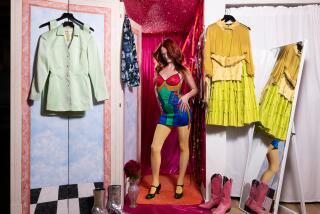The Correct Designer Can Help to Define a Company’s Identity
- Share via
When Unitek/3M, a Monrovia dental products maker, invented Transcend clear ceramic braces, marketing managers were convinced that the product would leave competitors breathless.
With that in mind, Unitek began searching for an advertising agency that could design everything from the Transcend logo to the packages and advertisements.
“We wanted a very strong brand name and a very strong logo,” recalled Tom Olsen, senior product manager for Transcend. “Ken White came back to us with 100 different logo layouts. To this day, the logo we chose is one of the most effective in the industry.”
The winning logo resembles the braces, featuring the word Transcend spelled out with vertical bars and spaces between the letters. The White & Associates campaign paid off handsomely when first-year sales for Transcend topped $10 million.
“A corporate image is synonymous with excellent products and quality of service,” said White, who has created designs for businesses ranging from a tiny, downtown Los Angeles vegetarian restaurant to a bed-and-breakfast castle in the south of France.
Finding a graphic designer whose taste you like and whose services you can afford takes time, but it certainly isn’t impossible; there are scores of designers to choose from in most big cities. Many small-business owners think that their companies are too small or broke to afford a professional designer. Instead, they ask an art student or a printer to whip up something to put on a business card or letterhead. Then this image takes hold and represents their company for years.
Designers, especially ones who own their own small businesses, say they welcome smaller clients because there is more room for creative expression. A new logo and image program can cost a business owner as little as $2,000.
“We tell people your identity is your greatest sales force because it speaks for you when you are not there,” said Peter Godefroy, a partner in Cohen Godefroy in Brentwood.
“If you don’t control your image, the public will come up with their own image of your company,” said Luke Strockis, White & Associates’ director of client services.
Professional graphic designers take an objective look at your company, seeing it as a new customer would. A good designer will interview you, your managers and key employees to learn everything they can about the business and your philosophy.
He or she will also analyze marketing strengths and weaknesses and figure out how you stack up with your competition. Unlike an employee, who may be reluctant to make suggestions to the owner or manager, a professional designer is not afraid to tell you the truth.
One excellent way to find a designer is to save brochures or advertisements that catch your eye and ask the company who did the work for them.
Before you begin interviewing designers, it’s best to sit down and figure out exactly what you think your company needs. Are you tired or bored with your old logo or trademark? Is there a way to freshen it up without jettisoning it altogether? Are you willing to accept suggestions from professionals, or are you wedded to your old image?
“It’s like shopping for anything else,” said Chris Garland, president of Garland CA, a new advertising design firm in Los Angeles. “You have to keep in mind the personality of the designer and how they will fit in with your business.”
Garland and his wife, Patti, recently moved west from Chicago, closing the design firm they founded there.
“Try to put yourself in your customers’ shoes when you make design decisions,” Chris Garland said. “Entrepreneurs have to be careful that their personal tastes do not overwhelm the customers’ tastes.”
Patti Garland said an effective product or service advertisement should bring in sales of about three times the amount of money you spend on it. And, she said, a company should plan on spending about 4% of its gross revenue on advertising and marketing.
Although buying brand names may be best for appliances, small-business owners can usually save money by hiring a small, independent design firm, rather than a major player in the industry.
“You can get a lot more for your dollar if you go with an independent,” Godefroy said. “Independents can frequently offer better prices than a big agency. The only thing an independent cannot offer is a name for a client to drop at a cocktail party.”
You can expect to spend between $2,500 and $15,000, depending on the extent of the services needed. Sometimes, having an eye-catching business card is the only thing a small-business owner needs. “People keep business cards,” Godefroy said. “You don’t have any credibility without one.”
HOW TO CHOOSE A DESIGNER
Save advertisements and brochures that you like, and ask the companies for the names of their designers.
Solicit presentations from several designers, but don’t go overboard.
When you have narrowed the field, ask for references and call other clients.
Insist on a very specific proposal, broken down into phases, so that you know exactly what to expect.
Find out how the designer plans to manage your project. Be sure to meet the actual person who will handle your account.
Find out which services will be handled in house and which will be subcontracted to others. Ask how much the subcontracted services will cost you.
More to Read
Inside the business of entertainment
The Wide Shot brings you news, analysis and insights on everything from streaming wars to production — and what it all means for the future.
You may occasionally receive promotional content from the Los Angeles Times.










